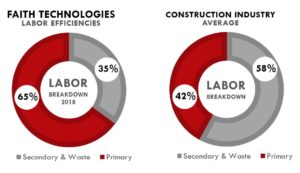01.22.2019
Recognizing Waste Time in a Construction Environment
 At Faith Technologies, our employees are empowered and encouraged to continue to redefine what’s possible, one of the four values that make up our culture. Historically, most construction companies have allowed waste time into their daily work, and in most cases, accepted it – but not at Faith. Taking a stance against this leaking faucet of lost revenue and labor hours, Faith has worked to identify these losses and began the journey of eliminating waste and increasing productivity.
At Faith Technologies, our employees are empowered and encouraged to continue to redefine what’s possible, one of the four values that make up our culture. Historically, most construction companies have allowed waste time into their daily work, and in most cases, accepted it – but not at Faith. Taking a stance against this leaking faucet of lost revenue and labor hours, Faith has worked to identify these losses and began the journey of eliminating waste and increasing productivity.
With our continued efforts to lead the industry through advancements in productivity, there comes a time for self-reflection. We are taking a much deeper dive to identify and eliminate waste that we have previously accepted as necessary. Eliminating the word necessary opens the opportunity to further scrutinize non-value-added activities for elimination. The progress we have made through our productivity program has been critical to the success of the company, but we know there are still areas to improve upon. One of the major reasons for our success is that we began to identify and capture waste time, instituting processes to eliminate waste, which led to many of the best practices we use today. Waste time is categorized as any unnecessary, non-value-added activity identified during a crew’s assigned task. Currently, identified waste time for the company hovers around 3 percent, a drastic decrease from the beginning of our efforts in 2009, when it was recorded at 29 percent!
There are 8 categories of waste in construction:
- Transportation – Unnecessarily moving materials or resources around a project without an intended purpose
- Inventory – Not having appropriate amounts of materials readily available, or having too much material on site
- Motion – At Faith we use the parameters of 5 feet/5 seconds – movement outside of this is considered waste
- Waiting – Waiting for material, other trades, information and/or co-workers
- Overproduction – Creating more work or manufactured assemblies than is immediately required for tasks
- Over-Processing – Additional, unnecessary steps within a task which result in doing more than the process requires
- Defects – Rework or errors in task completion
- Underutilized Resources – Failure to empower the worker and enable decision making at all levels
Primary time is defined as what the customer pays to be done. In order to increase a crew’s primary time and production, we must look at other aspects of what they are spending time on during their assigned tasks. With the use of manufactured assemblies from Excellerate and the incorporation of onsite logistic/material handling programs, crews focus more on value-added work, increasing not only their primary utilization time but also their output. This year our productivity team is facilitating fundamental changes to the way Productivity Time Study (PTS) data is recorded, with a focus of identifying waste time that is currently included in non-value added secondary time.
Items that will shift to waste include excessive movement outside of 5 feet/5 seconds, task set up/staging performed by electrical crews, rework of manufactured assemblies, not utilizing a tool belt when applicable, not properly utilizing site logistics team and resources, and poor housekeeping which impedes the crew from executing tasks. Many portions of secondary time that are required for task completion – i.e. handling tools or material and raising and lowering lifts – will continue to be captured, with a focus on minimizing these required functions. These changes will initially result in an increase in reported waste time; however, efforts can then be focused on reducing or eliminating this waste, enabling improvements in crew primary time and productive output. Many of these forms of waste can be positively impacted or eliminated through the incorporation of Kaizen – Rapid Improvement events. These efforts were outlined in a previous post by another member of our Productivity team.
As with most gains in productivity, these slight, compounded improvements are not earth-shattering, but come from small incremental changes to everyday processes. We then work to incorporate these changes such that they become positive habits, allowing us to continue to propel our innovative culture into future successes. Given the known labor shortages impacting construction, these improvements are critical to doing more with fewer resources. They also ensure Faith continues to increase what is recognized as best-in-business productivity.
One of Faith Technologies’ greatest differentiators is the support given to employees and engagement at all levels, ensuring continuous improvement is fostered and engrained in the culture. I challenge you to look for opportunities and identify forms of waste in your everyday work and implement improvements to increase your productivity.
If you enjoyed this blog article, please subscribe to stay up to date on the latest industry news from our experts at Faith Technologies.




